A Report on Latest Trends in Embedded Systems: Analyzing Adoption
VerifiedAdded on 2023/05/30
|13
|3772
|296
Report
AI Summary
This report analyzes the latest trends in embedded systems, focusing on factors that enable or constrain their adoption and the resulting impact on various industries. It identifies current trends, examines their influence on technological development, and explores potential future changes in the tech...

Running head: LATEST TRENDS IN EMBEDDED SYSTEM
Latest Trends in Embedded System
[Name of the student]
[Name of the University]
[Author note]
Latest Trends in Embedded System
[Name of the student]
[Name of the University]
[Author note]
Paraphrase This Document
Need a fresh take? Get an instant paraphrase of this document with our AI Paraphraser
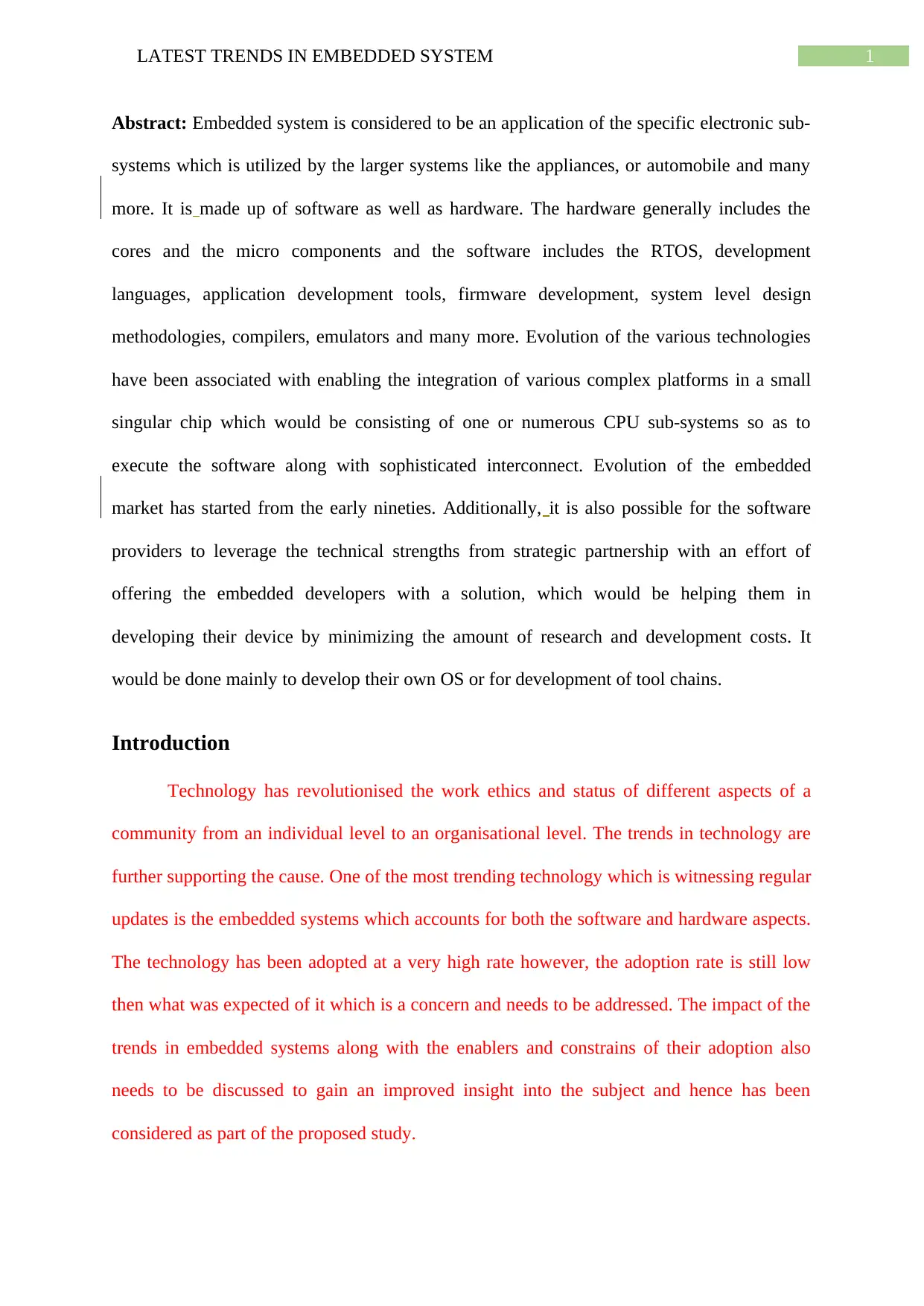
1LATEST TRENDS IN EMBEDDED SYSTEM
Abstract: Embedded system is considered to be an application of the specific electronic sub-
systems which is utilized by the larger systems like the appliances, or automobile and many
more. It is made up of software as well as hardware. The hardware generally includes the
cores and the micro components and the software includes the RTOS, development
languages, application development tools, firmware development, system level design
methodologies, compilers, emulators and many more. Evolution of the various technologies
have been associated with enabling the integration of various complex platforms in a small
singular chip which would be consisting of one or numerous CPU sub-systems so as to
execute the software along with sophisticated interconnect. Evolution of the embedded
market has started from the early nineties. Additionally, it is also possible for the software
providers to leverage the technical strengths from strategic partnership with an effort of
offering the embedded developers with a solution, which would be helping them in
developing their device by minimizing the amount of research and development costs. It
would be done mainly to develop their own OS or for development of tool chains.
Introduction
Technology has revolutionised the work ethics and status of different aspects of a
community from an individual level to an organisational level. The trends in technology are
further supporting the cause. One of the most trending technology which is witnessing regular
updates is the embedded systems which accounts for both the software and hardware aspects.
The technology has been adopted at a very high rate however, the adoption rate is still low
then what was expected of it which is a concern and needs to be addressed. The impact of the
trends in embedded systems along with the enablers and constrains of their adoption also
needs to be discussed to gain an improved insight into the subject and hence has been
considered as part of the proposed study.
Abstract: Embedded system is considered to be an application of the specific electronic sub-
systems which is utilized by the larger systems like the appliances, or automobile and many
more. It is made up of software as well as hardware. The hardware generally includes the
cores and the micro components and the software includes the RTOS, development
languages, application development tools, firmware development, system level design
methodologies, compilers, emulators and many more. Evolution of the various technologies
have been associated with enabling the integration of various complex platforms in a small
singular chip which would be consisting of one or numerous CPU sub-systems so as to
execute the software along with sophisticated interconnect. Evolution of the embedded
market has started from the early nineties. Additionally, it is also possible for the software
providers to leverage the technical strengths from strategic partnership with an effort of
offering the embedded developers with a solution, which would be helping them in
developing their device by minimizing the amount of research and development costs. It
would be done mainly to develop their own OS or for development of tool chains.
Introduction
Technology has revolutionised the work ethics and status of different aspects of a
community from an individual level to an organisational level. The trends in technology are
further supporting the cause. One of the most trending technology which is witnessing regular
updates is the embedded systems which accounts for both the software and hardware aspects.
The technology has been adopted at a very high rate however, the adoption rate is still low
then what was expected of it which is a concern and needs to be addressed. The impact of the
trends in embedded systems along with the enablers and constrains of their adoption also
needs to be discussed to gain an improved insight into the subject and hence has been
considered as part of the proposed study.

2LATEST TRENDS IN EMBEDDED SYSTEM
The paper has discussed different aspects of the study in discussion and has offered
the research aim, objectives along with other crucial aspects such as the significance,
expected outcome and others. A preliminary review over the subject has also been done to
gain an insight into the subject. The paper has also discussed the approach that will be
adopted as part of the paper and summarised the discussion in the conclusion section to
conclude on the paper.
Research Aim
The major aim of this paper is to analyze the latest Trends in embedded systemsalong
with the factors that acts as enabler or constraint and accordingly discuss the impact it will
have in the industry that adopt the system.
Research objective:
The objectives of the research work that will support the primary aim of the paper
have been listed below:
Finding the latest trends in embedded system
Finding the impact of technological adoption in the industries.
Finding the enables and constraints of embedded systems that drive the trends.
To identify the potential changes that may be evident in the technology in discussion
in the coming future?
Research questions
1. What are the current trends in embedded system?
2. How will it impact the technological development in the industry of adoption?
3. What are the enablers and constraints of the subject that drives the trends?
The paper has discussed different aspects of the study in discussion and has offered
the research aim, objectives along with other crucial aspects such as the significance,
expected outcome and others. A preliminary review over the subject has also been done to
gain an insight into the subject. The paper has also discussed the approach that will be
adopted as part of the paper and summarised the discussion in the conclusion section to
conclude on the paper.
Research Aim
The major aim of this paper is to analyze the latest Trends in embedded systemsalong
with the factors that acts as enabler or constraint and accordingly discuss the impact it will
have in the industry that adopt the system.
Research objective:
The objectives of the research work that will support the primary aim of the paper
have been listed below:
Finding the latest trends in embedded system
Finding the impact of technological adoption in the industries.
Finding the enables and constraints of embedded systems that drive the trends.
To identify the potential changes that may be evident in the technology in discussion
in the coming future?
Research questions
1. What are the current trends in embedded system?
2. How will it impact the technological development in the industry of adoption?
3. What are the enablers and constraints of the subject that drives the trends?
⊘ This is a preview!⊘
Do you want full access?
Subscribe today to unlock all pages.

Trusted by 1+ million students worldwide
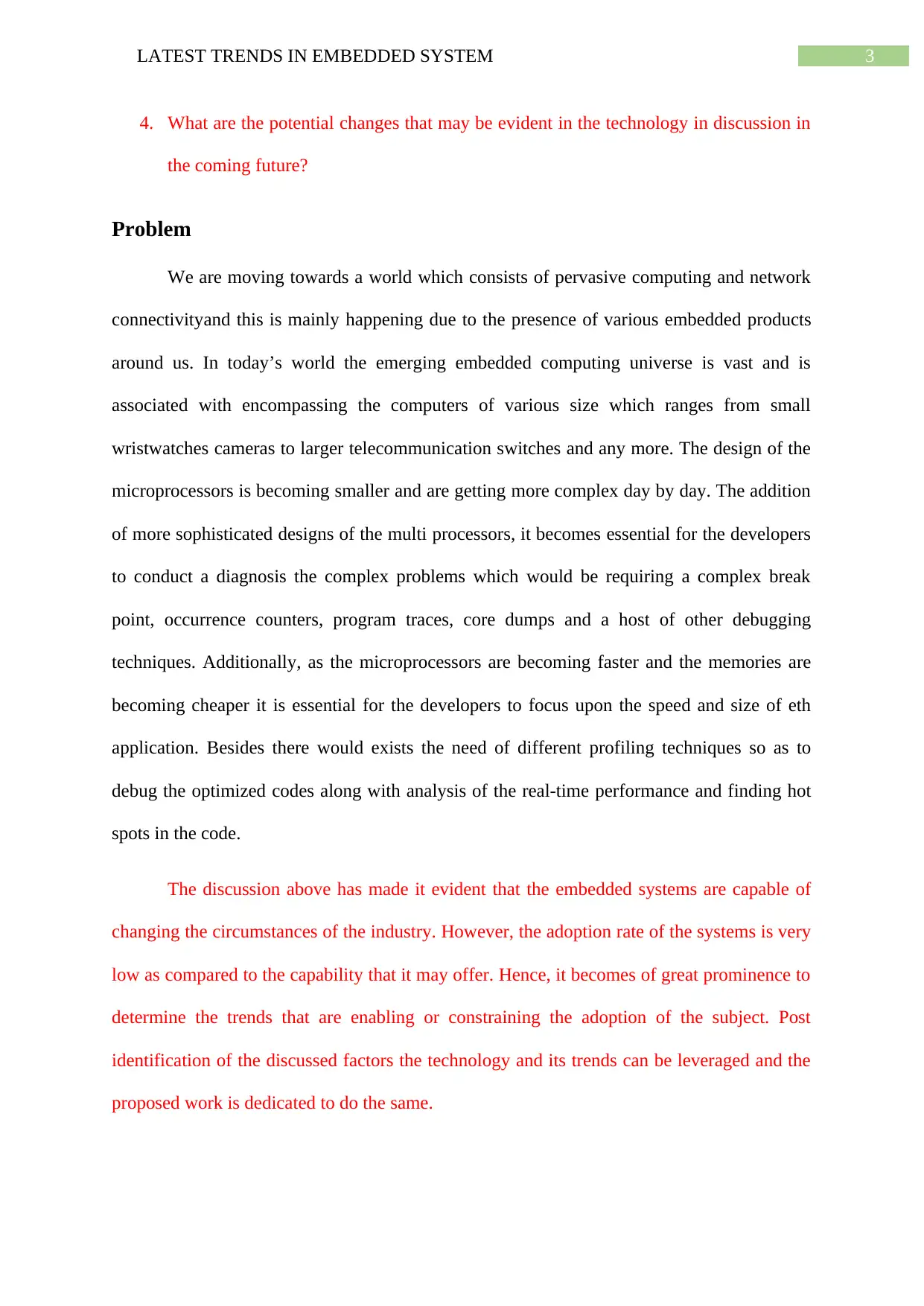
3LATEST TRENDS IN EMBEDDED SYSTEM
4. What are the potential changes that may be evident in the technology in discussion in
the coming future?
Problem
We are moving towards a world which consists of pervasive computing and network
connectivityand this is mainly happening due to the presence of various embedded products
around us. In today’s world the emerging embedded computing universe is vast and is
associated with encompassing the computers of various size which ranges from small
wristwatches cameras to larger telecommunication switches and any more. The design of the
microprocessors is becoming smaller and are getting more complex day by day. The addition
of more sophisticated designs of the multi processors, it becomes essential for the developers
to conduct a diagnosis the complex problems which would be requiring a complex break
point, occurrence counters, program traces, core dumps and a host of other debugging
techniques. Additionally, as the microprocessors are becoming faster and the memories are
becoming cheaper it is essential for the developers to focus upon the speed and size of eth
application. Besides there would exists the need of different profiling techniques so as to
debug the optimized codes along with analysis of the real-time performance and finding hot
spots in the code.
The discussion above has made it evident that the embedded systems are capable of
changing the circumstances of the industry. However, the adoption rate of the systems is very
low as compared to the capability that it may offer. Hence, it becomes of great prominence to
determine the trends that are enabling or constraining the adoption of the subject. Post
identification of the discussed factors the technology and its trends can be leveraged and the
proposed work is dedicated to do the same.
4. What are the potential changes that may be evident in the technology in discussion in
the coming future?
Problem
We are moving towards a world which consists of pervasive computing and network
connectivityand this is mainly happening due to the presence of various embedded products
around us. In today’s world the emerging embedded computing universe is vast and is
associated with encompassing the computers of various size which ranges from small
wristwatches cameras to larger telecommunication switches and any more. The design of the
microprocessors is becoming smaller and are getting more complex day by day. The addition
of more sophisticated designs of the multi processors, it becomes essential for the developers
to conduct a diagnosis the complex problems which would be requiring a complex break
point, occurrence counters, program traces, core dumps and a host of other debugging
techniques. Additionally, as the microprocessors are becoming faster and the memories are
becoming cheaper it is essential for the developers to focus upon the speed and size of eth
application. Besides there would exists the need of different profiling techniques so as to
debug the optimized codes along with analysis of the real-time performance and finding hot
spots in the code.
The discussion above has made it evident that the embedded systems are capable of
changing the circumstances of the industry. However, the adoption rate of the systems is very
low as compared to the capability that it may offer. Hence, it becomes of great prominence to
determine the trends that are enabling or constraining the adoption of the subject. Post
identification of the discussed factors the technology and its trends can be leveraged and the
proposed work is dedicated to do the same.
Paraphrase This Document
Need a fresh take? Get an instant paraphrase of this document with our AI Paraphraser
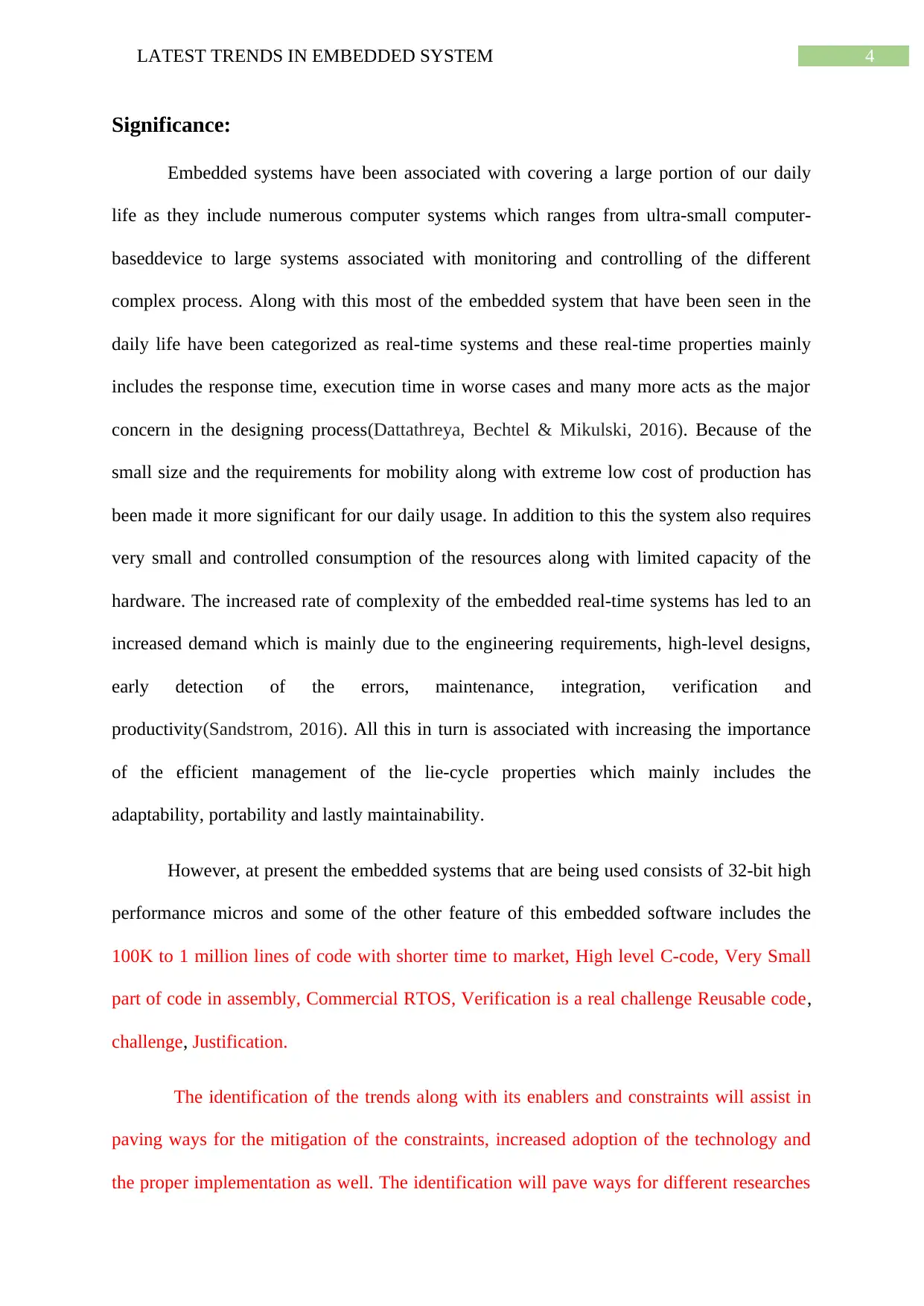
4LATEST TRENDS IN EMBEDDED SYSTEM
Significance:
Embedded systems have been associated with covering a large portion of our daily
life as they include numerous computer systems which ranges from ultra-small computer-
baseddevice to large systems associated with monitoring and controlling of the different
complex process. Along with this most of the embedded system that have been seen in the
daily life have been categorized as real-time systems and these real-time properties mainly
includes the response time, execution time in worse cases and many more acts as the major
concern in the designing process(Dattathreya, Bechtel & Mikulski, 2016). Because of the
small size and the requirements for mobility along with extreme low cost of production has
been made it more significant for our daily usage. In addition to this the system also requires
very small and controlled consumption of the resources along with limited capacity of the
hardware. The increased rate of complexity of the embedded real-time systems has led to an
increased demand which is mainly due to the engineering requirements, high-level designs,
early detection of the errors, maintenance, integration, verification and
productivity(Sandstrom, 2016). All this in turn is associated with increasing the importance
of the efficient management of the lie-cycle properties which mainly includes the
adaptability, portability and lastly maintainability.
However, at present the embedded systems that are being used consists of 32-bit high
performance micros and some of the other feature of this embedded software includes the
100K to 1 million lines of code with shorter time to market, High level C-code, Very Small
part of code in assembly, Commercial RTOS, Verification is a real challenge Reusable code,
challenge, Justification.
The identification of the trends along with its enablers and constraints will assist in
paving ways for the mitigation of the constraints, increased adoption of the technology and
the proper implementation as well. The identification will pave ways for different researches
Significance:
Embedded systems have been associated with covering a large portion of our daily
life as they include numerous computer systems which ranges from ultra-small computer-
baseddevice to large systems associated with monitoring and controlling of the different
complex process. Along with this most of the embedded system that have been seen in the
daily life have been categorized as real-time systems and these real-time properties mainly
includes the response time, execution time in worse cases and many more acts as the major
concern in the designing process(Dattathreya, Bechtel & Mikulski, 2016). Because of the
small size and the requirements for mobility along with extreme low cost of production has
been made it more significant for our daily usage. In addition to this the system also requires
very small and controlled consumption of the resources along with limited capacity of the
hardware. The increased rate of complexity of the embedded real-time systems has led to an
increased demand which is mainly due to the engineering requirements, high-level designs,
early detection of the errors, maintenance, integration, verification and
productivity(Sandstrom, 2016). All this in turn is associated with increasing the importance
of the efficient management of the lie-cycle properties which mainly includes the
adaptability, portability and lastly maintainability.
However, at present the embedded systems that are being used consists of 32-bit high
performance micros and some of the other feature of this embedded software includes the
100K to 1 million lines of code with shorter time to market, High level C-code, Very Small
part of code in assembly, Commercial RTOS, Verification is a real challenge Reusable code,
challenge, Justification.
The identification of the trends along with its enablers and constraints will assist in
paving ways for the mitigation of the constraints, increased adoption of the technology and
the proper implementation as well. The identification will pave ways for different researches

5LATEST TRENDS IN EMBEDDED SYSTEM
that will identify and support the above discussed potential findings of the paper.
Furthermore, the readers of the proposed work who will belong to corporate background may
use the findings to mitigate the threat and leverage the most disruptive embedded systems to
increase their productivity and ease of work.
Previous works
Energy management systems: state of the art and emerging trends
Authors: SaimaAman, YogeshSimmhan and Viktor K. Prasanna
This article gives an idea about the electric grid which evolving into a more advanced
and latest smart grid. The authors have explained the advantages of the smart grid over the
traditional electric grids. The advantages such as improved efficiency of energy as well as
management of available resources in a better way have all been discussed in details in this
article. Systems of energy management (EM) are often integrated with domestic automation
systems, which play a crucial role in keeping the energy consumed by the home appliances
under a check. These systems provide consumers with information about their energy
consumption patterns and help them adopt energy-efficient behavior (Sandstrom, 2016). The
emerging trends have only been discussed but not much of the details of the different
technologies behind these emerging trends in embedded system have been discussed in this
article like the ALIS or Adaptive Living Interface System. This is the emerging embedded
technology which acts as the backbone for information for the net-zero solar powered homes.
Emerging Frontiers in Embedded Security:
Authors: Mehran MozaffariKermani, Meng Zhang, AnandRaghunathan and Niraj K. Jha
This article gives an insight to the different kinds of Computing devices and platforms
available in today’s world. The authors have explained their different applications within the
that will identify and support the above discussed potential findings of the paper.
Furthermore, the readers of the proposed work who will belong to corporate background may
use the findings to mitigate the threat and leverage the most disruptive embedded systems to
increase their productivity and ease of work.
Previous works
Energy management systems: state of the art and emerging trends
Authors: SaimaAman, YogeshSimmhan and Viktor K. Prasanna
This article gives an idea about the electric grid which evolving into a more advanced
and latest smart grid. The authors have explained the advantages of the smart grid over the
traditional electric grids. The advantages such as improved efficiency of energy as well as
management of available resources in a better way have all been discussed in details in this
article. Systems of energy management (EM) are often integrated with domestic automation
systems, which play a crucial role in keeping the energy consumed by the home appliances
under a check. These systems provide consumers with information about their energy
consumption patterns and help them adopt energy-efficient behavior (Sandstrom, 2016). The
emerging trends have only been discussed but not much of the details of the different
technologies behind these emerging trends in embedded system have been discussed in this
article like the ALIS or Adaptive Living Interface System. This is the emerging embedded
technology which acts as the backbone for information for the net-zero solar powered homes.
Emerging Frontiers in Embedded Security:
Authors: Mehran MozaffariKermani, Meng Zhang, AnandRaghunathan and Niraj K. Jha
This article gives an insight to the different kinds of Computing devices and platforms
available in today’s world. The authors have explained their different applications within the
⊘ This is a preview!⊘
Do you want full access?
Subscribe today to unlock all pages.

Trusted by 1+ million students worldwide
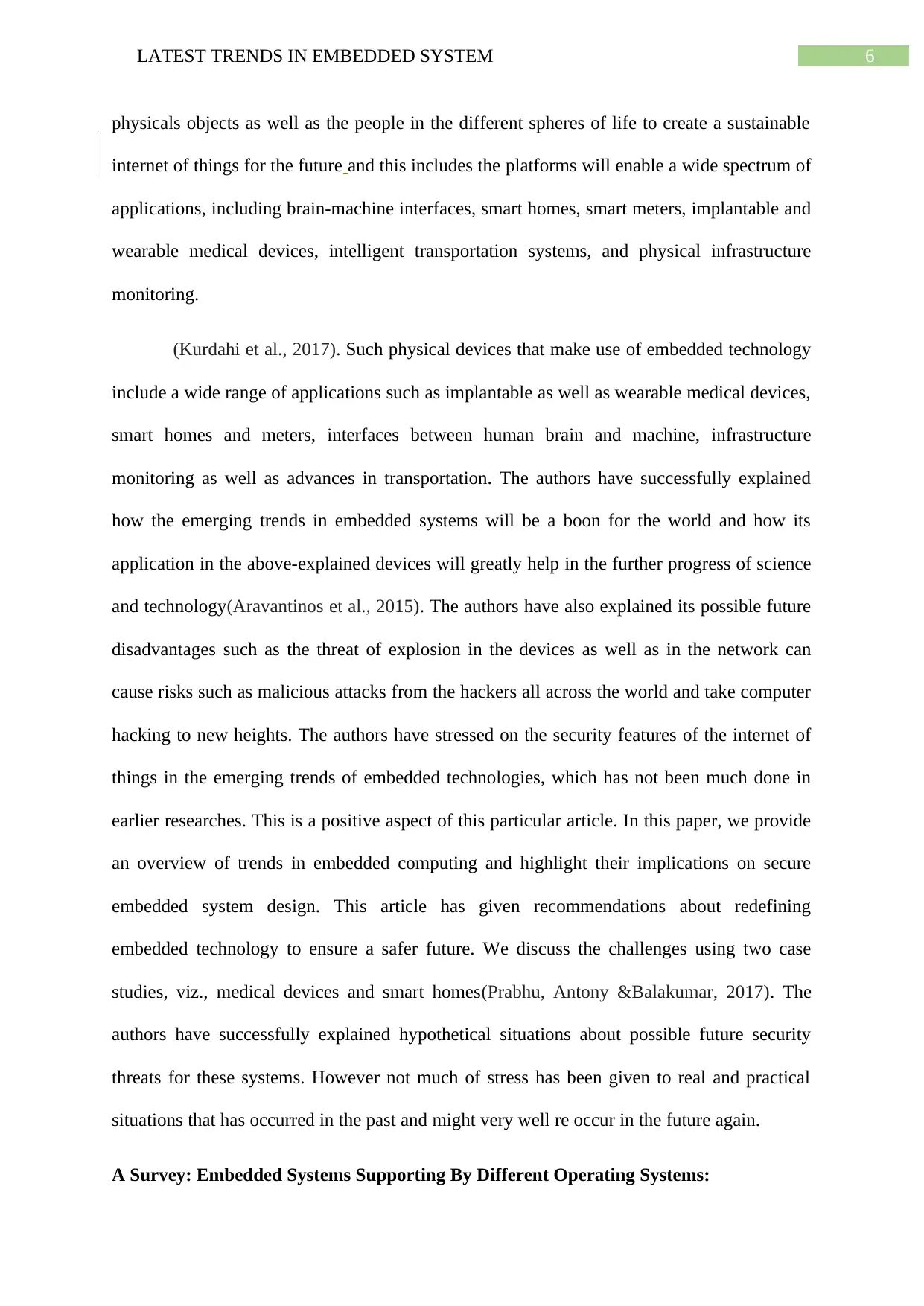
6LATEST TRENDS IN EMBEDDED SYSTEM
physicals objects as well as the people in the different spheres of life to create a sustainable
internet of things for the future and this includes the platforms will enable a wide spectrum of
applications, including brain-machine interfaces, smart homes, smart meters, implantable and
wearable medical devices, intelligent transportation systems, and physical infrastructure
monitoring.
(Kurdahi et al., 2017). Such physical devices that make use of embedded technology
include a wide range of applications such as implantable as well as wearable medical devices,
smart homes and meters, interfaces between human brain and machine, infrastructure
monitoring as well as advances in transportation. The authors have successfully explained
how the emerging trends in embedded systems will be a boon for the world and how its
application in the above-explained devices will greatly help in the further progress of science
and technology(Aravantinos et al., 2015). The authors have also explained its possible future
disadvantages such as the threat of explosion in the devices as well as in the network can
cause risks such as malicious attacks from the hackers all across the world and take computer
hacking to new heights. The authors have stressed on the security features of the internet of
things in the emerging trends of embedded technologies, which has not been much done in
earlier researches. This is a positive aspect of this particular article. In this paper, we provide
an overview of trends in embedded computing and highlight their implications on secure
embedded system design. This article has given recommendations about redefining
embedded technology to ensure a safer future. We discuss the challenges using two case
studies, viz., medical devices and smart homes(Prabhu, Antony &Balakumar, 2017). The
authors have successfully explained hypothetical situations about possible future security
threats for these systems. However not much of stress has been given to real and practical
situations that has occurred in the past and might very well re occur in the future again.
A Survey: Embedded Systems Supporting By Different Operating Systems:
physicals objects as well as the people in the different spheres of life to create a sustainable
internet of things for the future and this includes the platforms will enable a wide spectrum of
applications, including brain-machine interfaces, smart homes, smart meters, implantable and
wearable medical devices, intelligent transportation systems, and physical infrastructure
monitoring.
(Kurdahi et al., 2017). Such physical devices that make use of embedded technology
include a wide range of applications such as implantable as well as wearable medical devices,
smart homes and meters, interfaces between human brain and machine, infrastructure
monitoring as well as advances in transportation. The authors have successfully explained
how the emerging trends in embedded systems will be a boon for the world and how its
application in the above-explained devices will greatly help in the further progress of science
and technology(Aravantinos et al., 2015). The authors have also explained its possible future
disadvantages such as the threat of explosion in the devices as well as in the network can
cause risks such as malicious attacks from the hackers all across the world and take computer
hacking to new heights. The authors have stressed on the security features of the internet of
things in the emerging trends of embedded technologies, which has not been much done in
earlier researches. This is a positive aspect of this particular article. In this paper, we provide
an overview of trends in embedded computing and highlight their implications on secure
embedded system design. This article has given recommendations about redefining
embedded technology to ensure a safer future. We discuss the challenges using two case
studies, viz., medical devices and smart homes(Prabhu, Antony &Balakumar, 2017). The
authors have successfully explained hypothetical situations about possible future security
threats for these systems. However not much of stress has been given to real and practical
situations that has occurred in the past and might very well re occur in the future again.
A Survey: Embedded Systems Supporting By Different Operating Systems:
Paraphrase This Document
Need a fresh take? Get an instant paraphrase of this document with our AI Paraphraser
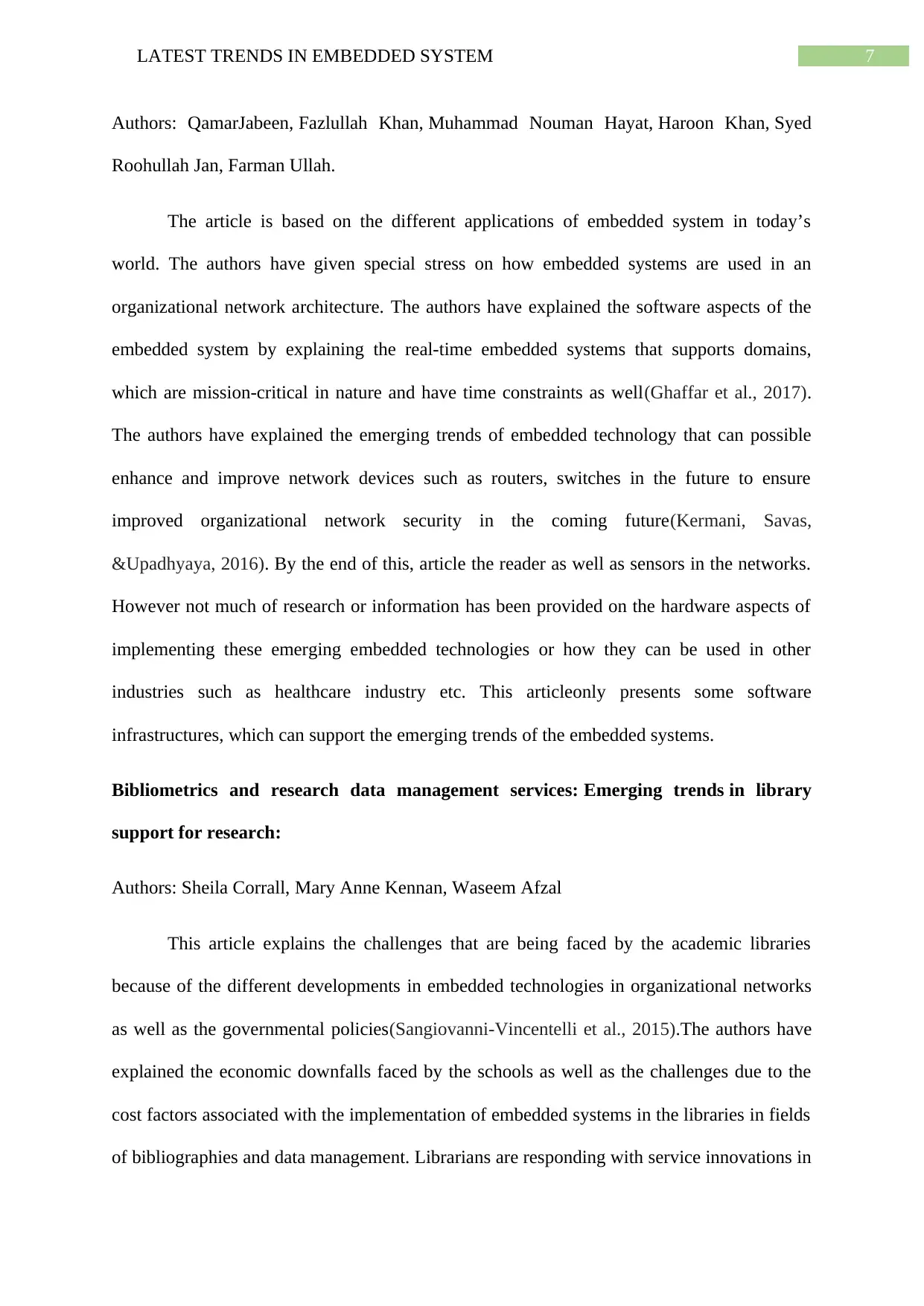
7LATEST TRENDS IN EMBEDDED SYSTEM
Authors: QamarJabeen, Fazlullah Khan, Muhammad Nouman Hayat, Haroon Khan, Syed
Roohullah Jan, Farman Ullah.
The article is based on the different applications of embedded system in today’s
world. The authors have given special stress on how embedded systems are used in an
organizational network architecture. The authors have explained the software aspects of the
embedded system by explaining the real-time embedded systems that supports domains,
which are mission-critical in nature and have time constraints as well(Ghaffar et al., 2017).
The authors have explained the emerging trends of embedded technology that can possible
enhance and improve network devices such as routers, switches in the future to ensure
improved organizational network security in the coming future(Kermani, Savas,
&Upadhyaya, 2016). By the end of this, article the reader as well as sensors in the networks.
However not much of research or information has been provided on the hardware aspects of
implementing these emerging embedded technologies or how they can be used in other
industries such as healthcare industry etc. This articleonly presents some software
infrastructures, which can support the emerging trends of the embedded systems.
Bibliometrics and research data management services: Emerging trends in library
support for research:
Authors: Sheila Corrall, Mary Anne Kennan, Waseem Afzal
This article explains the challenges that are being faced by the academic libraries
because of the different developments in embedded technologies in organizational networks
as well as the governmental policies(Sangiovanni-Vincentelli et al., 2015).The authors have
explained the economic downfalls faced by the schools as well as the challenges due to the
cost factors associated with the implementation of embedded systems in the libraries in fields
of bibliographies and data management. Librarians are responding with service innovations in
Authors: QamarJabeen, Fazlullah Khan, Muhammad Nouman Hayat, Haroon Khan, Syed
Roohullah Jan, Farman Ullah.
The article is based on the different applications of embedded system in today’s
world. The authors have given special stress on how embedded systems are used in an
organizational network architecture. The authors have explained the software aspects of the
embedded system by explaining the real-time embedded systems that supports domains,
which are mission-critical in nature and have time constraints as well(Ghaffar et al., 2017).
The authors have explained the emerging trends of embedded technology that can possible
enhance and improve network devices such as routers, switches in the future to ensure
improved organizational network security in the coming future(Kermani, Savas,
&Upadhyaya, 2016). By the end of this, article the reader as well as sensors in the networks.
However not much of research or information has been provided on the hardware aspects of
implementing these emerging embedded technologies or how they can be used in other
industries such as healthcare industry etc. This articleonly presents some software
infrastructures, which can support the emerging trends of the embedded systems.
Bibliometrics and research data management services: Emerging trends in library
support for research:
Authors: Sheila Corrall, Mary Anne Kennan, Waseem Afzal
This article explains the challenges that are being faced by the academic libraries
because of the different developments in embedded technologies in organizational networks
as well as the governmental policies(Sangiovanni-Vincentelli et al., 2015).The authors have
explained the economic downfalls faced by the schools as well as the challenges due to the
cost factors associated with the implementation of embedded systems in the libraries in fields
of bibliographies and data management. Librarians are responding with service innovations in
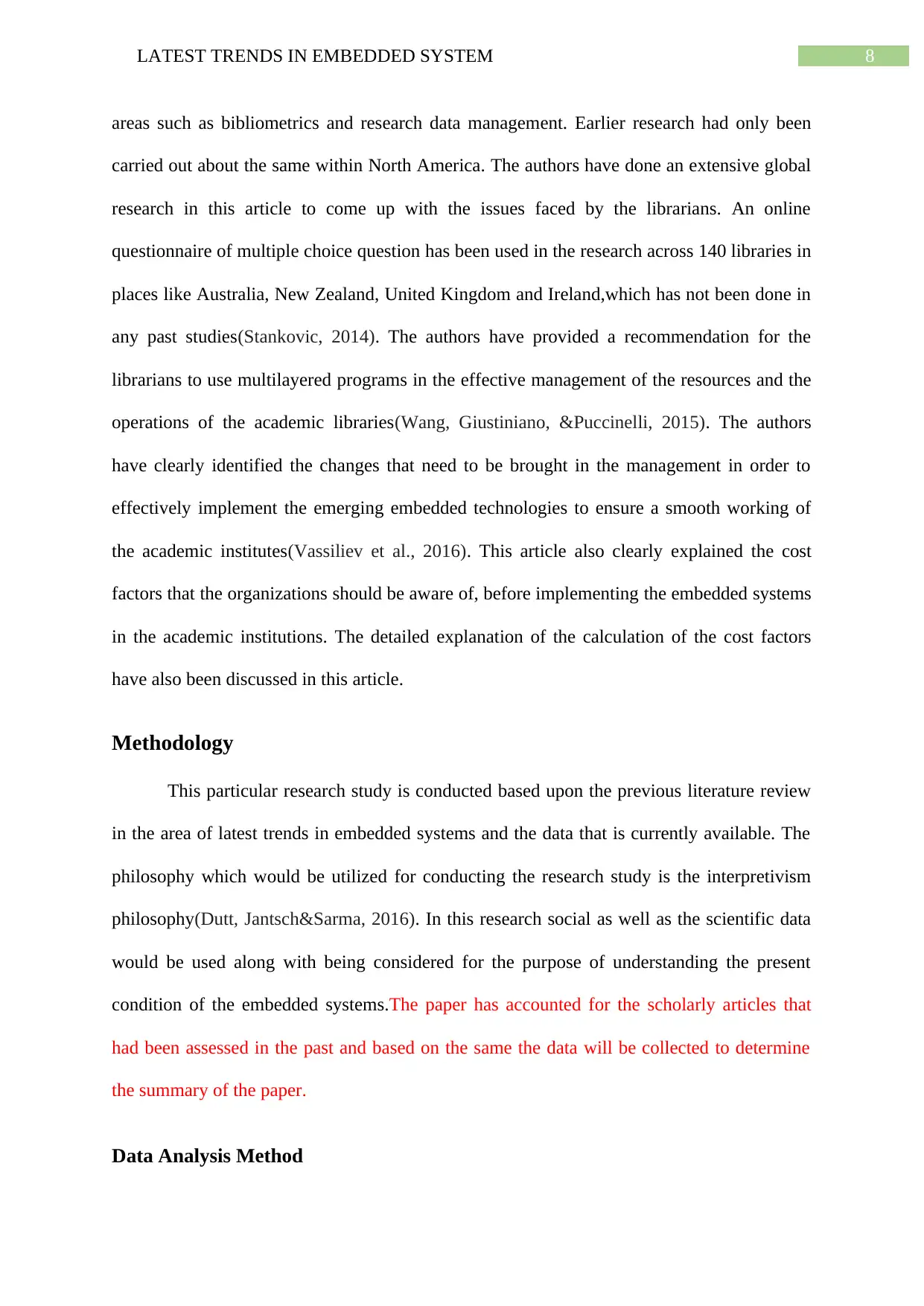
8LATEST TRENDS IN EMBEDDED SYSTEM
areas such as bibliometrics and research data management. Earlier research had only been
carried out about the same within North America. The authors have done an extensive global
research in this article to come up with the issues faced by the librarians. An online
questionnaire of multiple choice question has been used in the research across 140 libraries in
places like Australia, New Zealand, United Kingdom and Ireland,which has not been done in
any past studies(Stankovic, 2014). The authors have provided a recommendation for the
librarians to use multilayered programs in the effective management of the resources and the
operations of the academic libraries(Wang, Giustiniano, &Puccinelli, 2015). The authors
have clearly identified the changes that need to be brought in the management in order to
effectively implement the emerging embedded technologies to ensure a smooth working of
the academic institutes(Vassiliev et al., 2016). This article also clearly explained the cost
factors that the organizations should be aware of, before implementing the embedded systems
in the academic institutions. The detailed explanation of the calculation of the cost factors
have also been discussed in this article.
Methodology
This particular research study is conducted based upon the previous literature review
in the area of latest trends in embedded systems and the data that is currently available. The
philosophy which would be utilized for conducting the research study is the interpretivism
philosophy(Dutt, Jantsch&Sarma, 2016). In this research social as well as the scientific data
would be used along with being considered for the purpose of understanding the present
condition of the embedded systems.The paper has accounted for the scholarly articles that
had been assessed in the past and based on the same the data will be collected to determine
the summary of the paper.
Data Analysis Method
areas such as bibliometrics and research data management. Earlier research had only been
carried out about the same within North America. The authors have done an extensive global
research in this article to come up with the issues faced by the librarians. An online
questionnaire of multiple choice question has been used in the research across 140 libraries in
places like Australia, New Zealand, United Kingdom and Ireland,which has not been done in
any past studies(Stankovic, 2014). The authors have provided a recommendation for the
librarians to use multilayered programs in the effective management of the resources and the
operations of the academic libraries(Wang, Giustiniano, &Puccinelli, 2015). The authors
have clearly identified the changes that need to be brought in the management in order to
effectively implement the emerging embedded technologies to ensure a smooth working of
the academic institutes(Vassiliev et al., 2016). This article also clearly explained the cost
factors that the organizations should be aware of, before implementing the embedded systems
in the academic institutions. The detailed explanation of the calculation of the cost factors
have also been discussed in this article.
Methodology
This particular research study is conducted based upon the previous literature review
in the area of latest trends in embedded systems and the data that is currently available. The
philosophy which would be utilized for conducting the research study is the interpretivism
philosophy(Dutt, Jantsch&Sarma, 2016). In this research social as well as the scientific data
would be used along with being considered for the purpose of understanding the present
condition of the embedded systems.The paper has accounted for the scholarly articles that
had been assessed in the past and based on the same the data will be collected to determine
the summary of the paper.
Data Analysis Method
⊘ This is a preview!⊘
Do you want full access?
Subscribe today to unlock all pages.

Trusted by 1+ million students worldwide

9LATEST TRENDS IN EMBEDDED SYSTEM
For this research work we would only be using the qualitative data. The finding of the
literature review would be compared and the declarations of the review would be
differentiated and the disclosures of the investigation study would be helping in
understanding the latest trend in the embedded system and this would be entirely penniless
irrespective of the fact that the objectives of the examination study are met or not.
Expected outcomes
The results that are expected from this research would be including the various type of
trends in the embedded system along with the various challenges and opportunities that are
likely to be obtained from the latest trends. The literature review conducted in the research
study would be helping a lot in understanding the latest trends in embedded system along
with helping in understanding the possible challenges that are likely to be faced by the new
technologies that would be using the embedded systems. Furthermore, the objective of the
paper is also aimed at determining the enablers and constraints of the trends which are
impacting the trends from being leveraged. Hence, those enablers and constraints will be
identified which will prove crucial for the adoption ratio of the technology in discussion.
Conclusion
Embedded systems have emerged as one of the potential technology that can
revolutionised the industries and the productivity of those industries. Furthermore, the latest
trends are capable of further enhancing the scenario however, the adoption ratio of the
technology is low. Hence, the paper is aimed at identifying the trends of embedded systems
along with the enablers and constraints of the adoption which is further extended to discuss
theimpact of subject on the industries. The paper has discussed different aspects of the
proposed work and what will be done to attain the aim of the paper. Review of the literary
work, methodology, expected outcome and others have been discussed so that the readers can
For this research work we would only be using the qualitative data. The finding of the
literature review would be compared and the declarations of the review would be
differentiated and the disclosures of the investigation study would be helping in
understanding the latest trend in the embedded system and this would be entirely penniless
irrespective of the fact that the objectives of the examination study are met or not.
Expected outcomes
The results that are expected from this research would be including the various type of
trends in the embedded system along with the various challenges and opportunities that are
likely to be obtained from the latest trends. The literature review conducted in the research
study would be helping a lot in understanding the latest trends in embedded system along
with helping in understanding the possible challenges that are likely to be faced by the new
technologies that would be using the embedded systems. Furthermore, the objective of the
paper is also aimed at determining the enablers and constraints of the trends which are
impacting the trends from being leveraged. Hence, those enablers and constraints will be
identified which will prove crucial for the adoption ratio of the technology in discussion.
Conclusion
Embedded systems have emerged as one of the potential technology that can
revolutionised the industries and the productivity of those industries. Furthermore, the latest
trends are capable of further enhancing the scenario however, the adoption ratio of the
technology is low. Hence, the paper is aimed at identifying the trends of embedded systems
along with the enablers and constraints of the adoption which is further extended to discuss
theimpact of subject on the industries. The paper has discussed different aspects of the
proposed work and what will be done to attain the aim of the paper. Review of the literary
work, methodology, expected outcome and others have been discussed so that the readers can
Paraphrase This Document
Need a fresh take? Get an instant paraphrase of this document with our AI Paraphraser
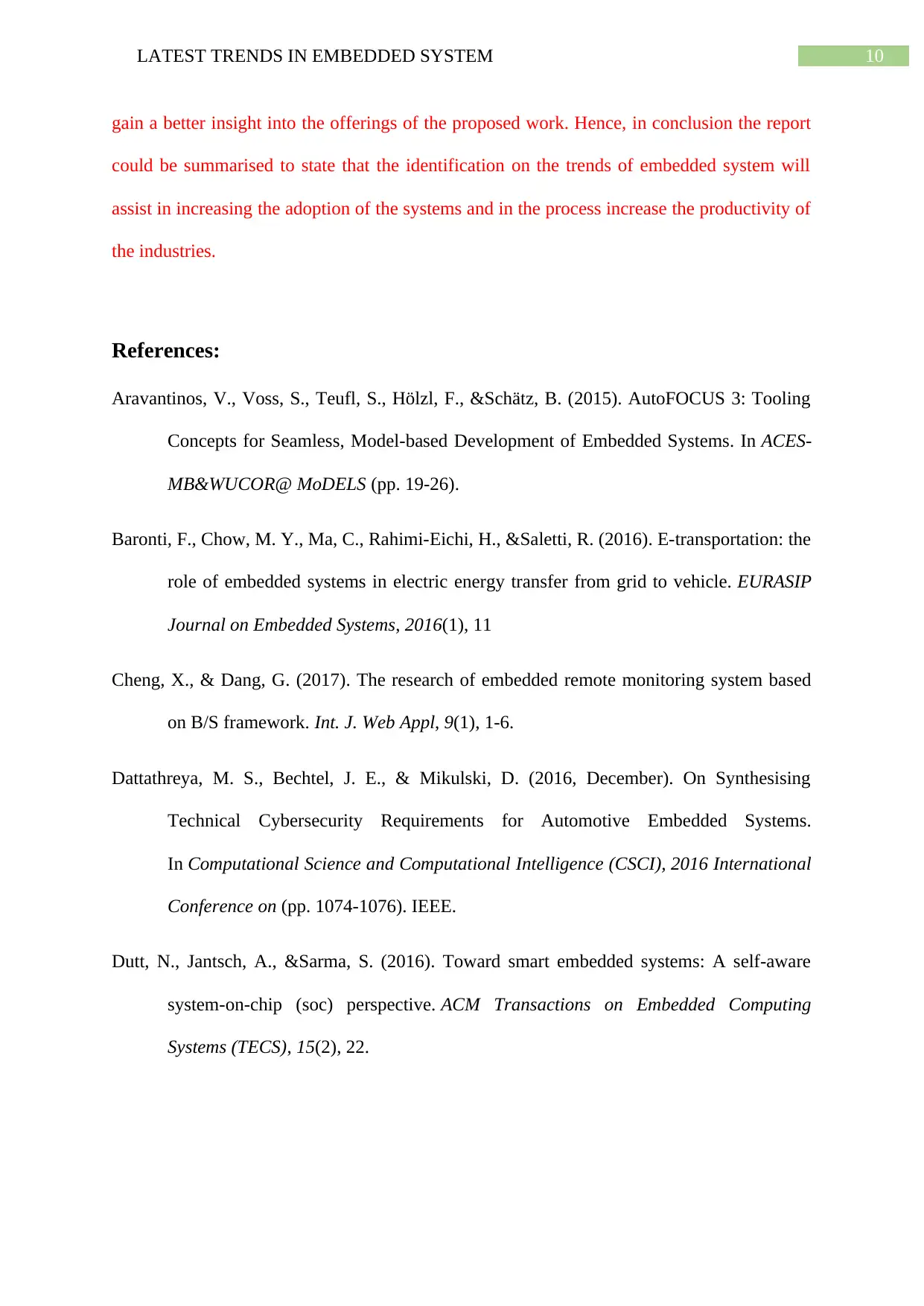
10LATEST TRENDS IN EMBEDDED SYSTEM
gain a better insight into the offerings of the proposed work. Hence, in conclusion the report
could be summarised to state that the identification on the trends of embedded system will
assist in increasing the adoption of the systems and in the process increase the productivity of
the industries.
References:
Aravantinos, V., Voss, S., Teufl, S., Hölzl, F., &Schätz, B. (2015). AutoFOCUS 3: Tooling
Concepts for Seamless, Model-based Development of Embedded Systems. In ACES-
MB&WUCOR@ MoDELS (pp. 19-26).
Baronti, F., Chow, M. Y., Ma, C., Rahimi-Eichi, H., &Saletti, R. (2016). E-transportation: the
role of embedded systems in electric energy transfer from grid to vehicle. EURASIP
Journal on Embedded Systems, 2016(1), 11
Cheng, X., & Dang, G. (2017). The research of embedded remote monitoring system based
on B/S framework. Int. J. Web Appl, 9(1), 1-6.
Dattathreya, M. S., Bechtel, J. E., & Mikulski, D. (2016, December). On Synthesising
Technical Cybersecurity Requirements for Automotive Embedded Systems.
In Computational Science and Computational Intelligence (CSCI), 2016 International
Conference on (pp. 1074-1076). IEEE.
Dutt, N., Jantsch, A., &Sarma, S. (2016). Toward smart embedded systems: A self-aware
system-on-chip (soc) perspective. ACM Transactions on Embedded Computing
Systems (TECS), 15(2), 22.
gain a better insight into the offerings of the proposed work. Hence, in conclusion the report
could be summarised to state that the identification on the trends of embedded system will
assist in increasing the adoption of the systems and in the process increase the productivity of
the industries.
References:
Aravantinos, V., Voss, S., Teufl, S., Hölzl, F., &Schätz, B. (2015). AutoFOCUS 3: Tooling
Concepts for Seamless, Model-based Development of Embedded Systems. In ACES-
MB&WUCOR@ MoDELS (pp. 19-26).
Baronti, F., Chow, M. Y., Ma, C., Rahimi-Eichi, H., &Saletti, R. (2016). E-transportation: the
role of embedded systems in electric energy transfer from grid to vehicle. EURASIP
Journal on Embedded Systems, 2016(1), 11
Cheng, X., & Dang, G. (2017). The research of embedded remote monitoring system based
on B/S framework. Int. J. Web Appl, 9(1), 1-6.
Dattathreya, M. S., Bechtel, J. E., & Mikulski, D. (2016, December). On Synthesising
Technical Cybersecurity Requirements for Automotive Embedded Systems.
In Computational Science and Computational Intelligence (CSCI), 2016 International
Conference on (pp. 1074-1076). IEEE.
Dutt, N., Jantsch, A., &Sarma, S. (2016). Toward smart embedded systems: A self-aware
system-on-chip (soc) perspective. ACM Transactions on Embedded Computing
Systems (TECS), 15(2), 22.
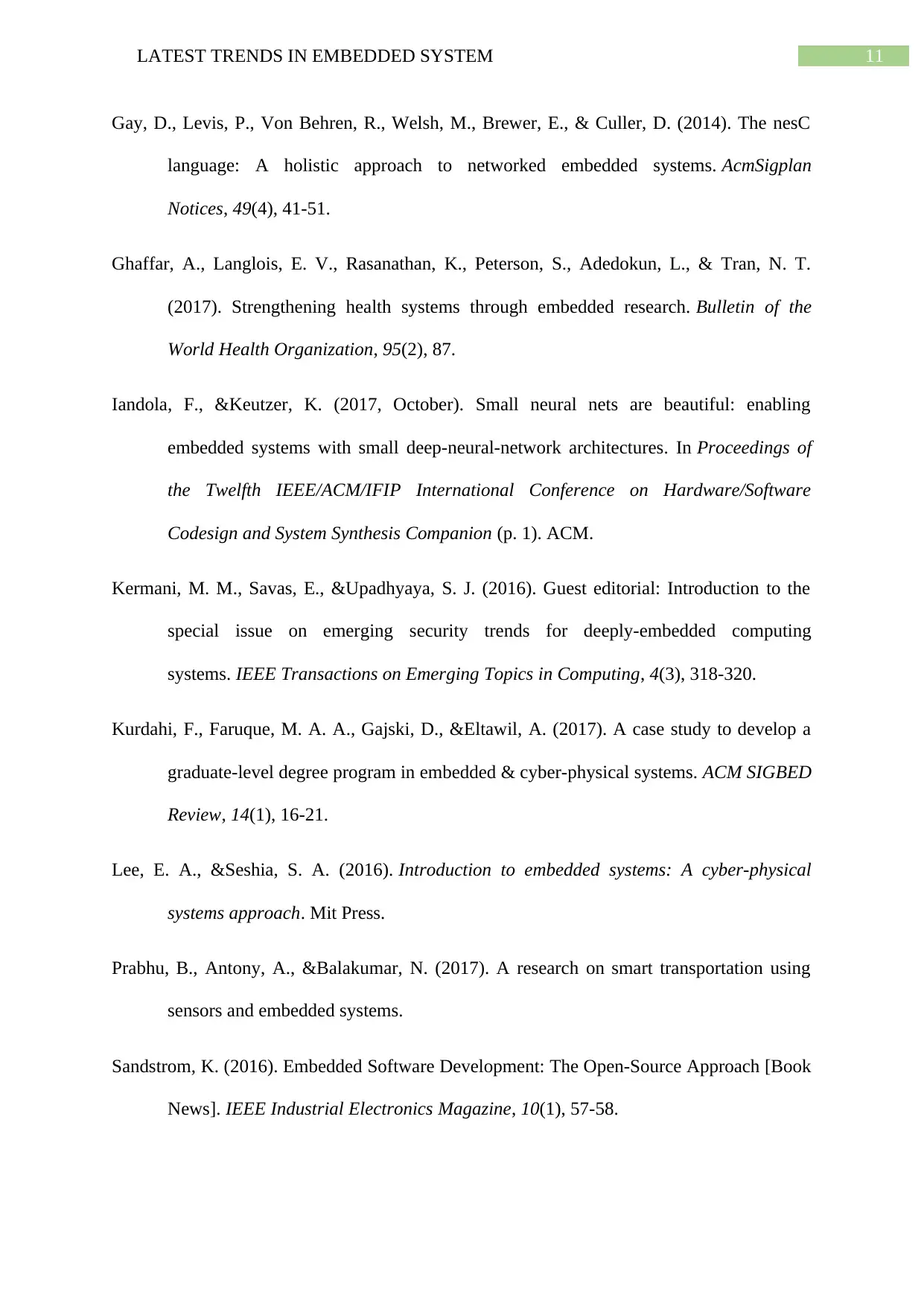
11LATEST TRENDS IN EMBEDDED SYSTEM
Gay, D., Levis, P., Von Behren, R., Welsh, M., Brewer, E., & Culler, D. (2014). The nesC
language: A holistic approach to networked embedded systems. AcmSigplan
Notices, 49(4), 41-51.
Ghaffar, A., Langlois, E. V., Rasanathan, K., Peterson, S., Adedokun, L., & Tran, N. T.
(2017). Strengthening health systems through embedded research. Bulletin of the
World Health Organization, 95(2), 87.
Iandola, F., &Keutzer, K. (2017, October). Small neural nets are beautiful: enabling
embedded systems with small deep-neural-network architectures. In Proceedings of
the Twelfth IEEE/ACM/IFIP International Conference on Hardware/Software
Codesign and System Synthesis Companion (p. 1). ACM.
Kermani, M. M., Savas, E., &Upadhyaya, S. J. (2016). Guest editorial: Introduction to the
special issue on emerging security trends for deeply-embedded computing
systems. IEEE Transactions on Emerging Topics in Computing, 4(3), 318-320.
Kurdahi, F., Faruque, M. A. A., Gajski, D., &Eltawil, A. (2017). A case study to develop a
graduate-level degree program in embedded & cyber-physical systems. ACM SIGBED
Review, 14(1), 16-21.
Lee, E. A., &Seshia, S. A. (2016). Introduction to embedded systems: A cyber-physical
systems approach. Mit Press.
Prabhu, B., Antony, A., &Balakumar, N. (2017). A research on smart transportation using
sensors and embedded systems.
Sandstrom, K. (2016). Embedded Software Development: The Open-Source Approach [Book
News]. IEEE Industrial Electronics Magazine, 10(1), 57-58.
Gay, D., Levis, P., Von Behren, R., Welsh, M., Brewer, E., & Culler, D. (2014). The nesC
language: A holistic approach to networked embedded systems. AcmSigplan
Notices, 49(4), 41-51.
Ghaffar, A., Langlois, E. V., Rasanathan, K., Peterson, S., Adedokun, L., & Tran, N. T.
(2017). Strengthening health systems through embedded research. Bulletin of the
World Health Organization, 95(2), 87.
Iandola, F., &Keutzer, K. (2017, October). Small neural nets are beautiful: enabling
embedded systems with small deep-neural-network architectures. In Proceedings of
the Twelfth IEEE/ACM/IFIP International Conference on Hardware/Software
Codesign and System Synthesis Companion (p. 1). ACM.
Kermani, M. M., Savas, E., &Upadhyaya, S. J. (2016). Guest editorial: Introduction to the
special issue on emerging security trends for deeply-embedded computing
systems. IEEE Transactions on Emerging Topics in Computing, 4(3), 318-320.
Kurdahi, F., Faruque, M. A. A., Gajski, D., &Eltawil, A. (2017). A case study to develop a
graduate-level degree program in embedded & cyber-physical systems. ACM SIGBED
Review, 14(1), 16-21.
Lee, E. A., &Seshia, S. A. (2016). Introduction to embedded systems: A cyber-physical
systems approach. Mit Press.
Prabhu, B., Antony, A., &Balakumar, N. (2017). A research on smart transportation using
sensors and embedded systems.
Sandstrom, K. (2016). Embedded Software Development: The Open-Source Approach [Book
News]. IEEE Industrial Electronics Magazine, 10(1), 57-58.
⊘ This is a preview!⊘
Do you want full access?
Subscribe today to unlock all pages.

Trusted by 1+ million students worldwide

12LATEST TRENDS IN EMBEDDED SYSTEM
Sangiovanni-Vincentelli, A., Zeng, H., Di Natale, M., &Marwedel, P. (2015). Embedded
systems development. Springer.
Stankovic, J. A. (2014). Research directions for the internet of things. IEEE Internet of
Things Journal, 1(1), 3-9.
Vassiliev, A. E., Ivanova, T. Y., Tapia, D. C., & Luong, Q. T. (2016, November).
Microcontroller-based embedded system equipment development for research and
educational support. In 2016 International Conference on Information Management
and Technology (ICIMTech) (pp. 219-223). IEEE.
Wang, Q., Giustiniano, D., &Puccinelli, D. (2015). An open source research platform for
embedded visible light networking. IEEE Wireless Communications, 22(2), 94-100.
Sangiovanni-Vincentelli, A., Zeng, H., Di Natale, M., &Marwedel, P. (2015). Embedded
systems development. Springer.
Stankovic, J. A. (2014). Research directions for the internet of things. IEEE Internet of
Things Journal, 1(1), 3-9.
Vassiliev, A. E., Ivanova, T. Y., Tapia, D. C., & Luong, Q. T. (2016, November).
Microcontroller-based embedded system equipment development for research and
educational support. In 2016 International Conference on Information Management
and Technology (ICIMTech) (pp. 219-223). IEEE.
Wang, Q., Giustiniano, D., &Puccinelli, D. (2015). An open source research platform for
embedded visible light networking. IEEE Wireless Communications, 22(2), 94-100.
1 out of 13
Related Documents
Your All-in-One AI-Powered Toolkit for Academic Success.
+13062052269
info@desklib.com
Available 24*7 on WhatsApp / Email
![[object Object]](/_next/static/media/star-bottom.7253800d.svg)
Unlock your academic potential
© 2024 | Zucol Services PVT LTD | All rights reserved.





